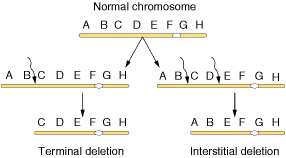|
Links |
Mode of Inheritance | |||||
|
Initial Discovery and Clinical Aspects Molecular/Biochemical Properties and Characteristics of Cri Du Chat-Related Proteins Links to Cri Du Chat Support Groups
|
Cri du Chat Syndrome is typically not related to inheritance issues from parent to offspring. Most cases (80-85%) are due sporadic de novo deletion of 5p arm. Therefore, genetic mutations often occur either in the egg or sperm or during early fetal development. Also, the child born with this deletion is often the first one in his or her family to be affected. In 10-15% of cases, the syndrome is attributable to the fact that one parent is a carrier of a balanced translocation involving the short arm of chromosome 5 and another chromosome. Translocations occur when segments of two different chromosomes are mutually exchanged. The resulting translocation is called balanced if no chromosome material is lost or gained and no genes are damaged by the breakages in the chromosomes.
Figure 17-2. Terminal and interstitial deletions. Chromosome can be broken when struck by ionizing radiation (wavy arrows). A terminal deletion is the loss of the end of a chromosome. An interstitial deletion results after two breaks are induced if the terminal part (AB) rejoins the main body of the chromosome, with the acentric fragment (CD) being lost. (Picture and figure legend taken from Modern Genetic Analysis edited by Sarah Tenney) A parent who carries a balanced translocation will not be affected. However, an individual with a balanced translocation has an increased risk of giving birth to children with imbalanced chromosomal aberrations causing congenital abnormalities. The chances that a newborn will be affected by the balanced translocation:
Most of the 5p terminal deletions occur with 30-60% loss of genetic material which often involve anywhere from 5-40 Mb. Fewer that 10% of cases involving CdCS have other types of rare cytogenetic aberrations, such as interstitial deletions, mosaicisms, rings and de novo translocations.
(Picture taken from Modern Genetic Analysis edited by Sarah Tenney) As we can see from these cases, many of the cases of CdCS are either isolated to the affected offspring or are due to the genetic make-up of the parent and therefore, long lines of hereditable cases of CdCS are not seen and a pedigree analysis is not needed.
|
|||||

